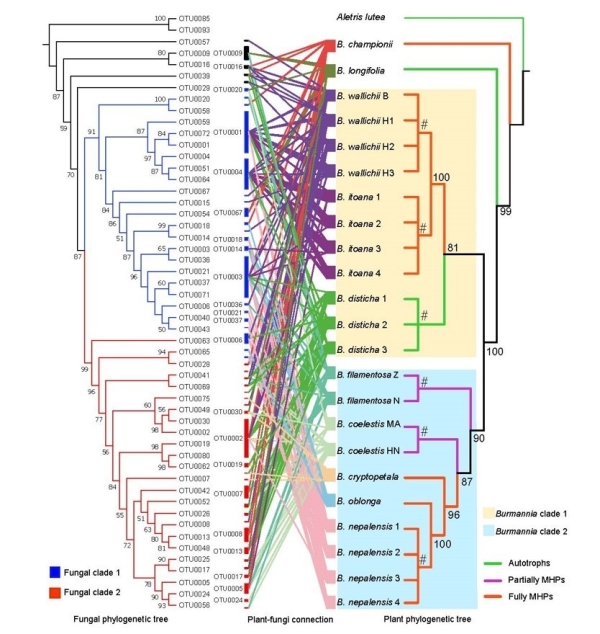Researchers reveal host preference and specialization toward fungal assemblages in mycoheterotrophs
Mycoheterotrophs are a group of plants having lost chlorophylls, parasitic on mycorrhizal fungi. They are the ‘aliens’ of the plant world because of their rarity and weird looks. Non-green full mycoheterotrophs live their life completely depending on fungi, usually maintain more specialized fungal relationships than autotrophs: it is thought that the plant-fungi interactions may have driven their evolution. However, it remains poorly known about the relationships between mycoheterotrophs and fungal partners: for example, do mycoheterotrophs select their fungal partners inheritably stable or recruit their partners locally?
The genus Burmannia (Burmanniaceae) is one of the few genera of land plants that contain both fully mycoheterotrophic species and green autotrophic species (Fig. 1). Therefore, it provides an excellent chance to study the change in fungal partners that accompanies the evolution of mycoheterotrophy. Recently, ZHAO Zhongtao and collaborators from South China Botanical Garden of Chinese Academy of Sciences collected a large number of different species from South China and southeast Asia, including autotrophs, partial mycoheterotrophs, and full mycoheterotrophs, and investigated the fungal communities in the plant roots using DNA sequencing methods. Their results exhibited how each of the Burmannia species interact with arbuscular mycorrhizal fungi (Fig. 2): although many fungal species were shared by different Burmannia species, fully mycoheterotrophic species typically host species-specific fungal assemblages, suggesting that they have a preference for the selected fungi.
The authors suggested that the specialization toward fungal assemblages in mycoheterotrophs may be helpful in improving nutritional efficiency for plant parasites, and might be a balance of maximizing benefit from their fungal partners and increasing diversity of fungal partners to explore niche breadth. These fungi are a subset of the partners found in the autotrophic species, suggesting that the specialization results from a loss in fungal partners. Interestingly, although mycoheterotrophs have such tight relationships with their fungal partners, researchers found no apparent co-phylogenetic relationships between them.
This study has been online published in The ISME Journal with the title “Specificity of assemblage, not fungal partner species, explains mycorrhizal partnerships of mycoheterotrophic Burmannia plants”. For further reading, please refer to: https://doi.org/10.1038/s41396-020-00874-x.

Fig. 1 Autotrophs, partial mycoheterotrophs, and full mycoheterotrophs in Burmannia

Fig. 2 Plants–fungi connection network based on phylogenetic relationships
File Download: